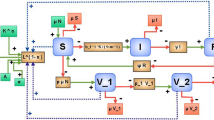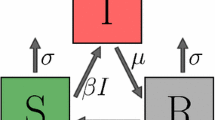Abstract
The impacts of pandemic situation on the health and economy of any nation are indeed significant. Several paradigms are present, where the nations’s economy has stumbled due to impact of infectious diseases. Hence, we formulate an econo-epidemics model to study economic impact of infectious disease. The structure is amalgamated with Solow growth functions to describe effect of epidemiological factors on economy. Numerous numerical experiments, viz. bifurcation analysis, production of capital growth profile, etc., is conducted to provide valuable insights into the potential outcomes and dynamics of the economy. Additionally, we consider the impact of demographic stochasticity on the economy of third-tier countries, Bangladesh and Tanzania, as these nations face unique challenges and vulnerabilities. Enumeration of probability of economic losses in upcoming years and stationary distributions on the capital growth data of those countries provide an outline of strengthening the economy after a period of depreciation caused by an infectious disease outbreak. Overall, the statistical experiments and analysis of capital data provide valuable information about the potential economic consequences of infectious diseases. This knowledge can guide the formulation of policies and schemes to mitigate economic disasters in the future and promote a resilient economy that is better prepared to handle pandemics.














Similar content being viewed by others
Data availability statement
No Data are associated in the manuscript.
References
F. Karim, S. Chauhan, J. Dhar, Analyzing an epidemic-economic model in the presence of novel corona virus infection: capital stabilization, media effect, and the role of vaccine. The European Physical Journal Special Topics. 1–18 (2022)
R. Blundell, L. Pistaferri, I. Saporta-Eksten, Consumption inequality and family labor supply. Am. Econ. Rev. 106(2), 387–435 (2016)
A.K. Dutt, Aggregate demand, aggregate supply and economic growth. Int. Rev. Appl. Econ. 20(3), 319–336 (2006)
D.J. Gubler, The economic burden of dengue. Am. J. Trop. Med. Hyg. 86(5), 743 (2012)
M.A. Mikheeva, I.V. Mikheeva, Ranking dynamics of economic burden of infectious diseases as a criterion of effectiveness of epidemiologic control. J. Microbiol. Epidemiol. Immunobiol. 97(2), 174–181 (2020)
J.M. Kirigia, L.G. Sambo, A. Yokouide, E. Soumbey-Alley, L.K. Muthuri, D.G. Kirigia, Economic burden of cholera in the WHO African region. BMC Int. Health Human Rights 9, 1–14 (2009)
A. Paul, S. Reja, S. Kundu, S. Bhattacharya, COVID-19 pandemic models revisited with a new proposal: Plenty of epidemiological models outcast the simple population dynamics solution. Chaos, Solitons & Fractals. 144, 110697 (2021)
W.H. Organization et al., Guidelines for cholera control (World Health Organization, 1993)
S. Hosek, A. Pettifor, HIV prevention interventions for adolescents. Current HIV/AIDS Reports. 16, 120–128 (2019)
M. Nicola, Z. Alsafi, C. Sohrabi, A. Kerwan, A. Al-Jabir, C. Iosifidis et al., The socio-economic implications of the coronavirus pandemic (COVID-19): a review. Int. J. Surg. 78, 185–193 (2020)
L. Thunström, S.C. Newbold, D. Finnoff, M. Ashworth, J.F. Shogren, The benefits and costs of using social distancing to flatten the curve for COVID-19. J. Benefit-Cost Anal. 11(2), 179–195 (2020)
V. Mogasale, V.V. Mogasale, A. Hsiao, Economic burden of cholera in Asia. Vaccine 38, A160–A166 (2020)
D. Ganesan, S.S. Gupta, D. Legros, Cholera surveillance and estimation of burden of cholera. Vaccine 38, A13–A17 (2020)
C.B. Barrett, J.G. McPeak, Poverty traps and safety nets. In: Poverty, inequality and development. Springer; pp. 131–154 (2006)
M.M. Pluciński, C.N. Ngonghala, M.H. Bonds, Health safety nets can break cycles of poverty and disease: a stochastic ecological model. J. Royal Soc. Interf. 8(65), 1796–1803 (2011)
M.H. Bonds, D.C. Keenan, P. Rohani, J.D. Sachs, Poverty trap formed by the ecology of infectious diseases. Proc. Royal Soc. B Biol. Sci. 277(1685), 1185–1192 (2010)
M.H. Bonds, A.P. Dobson, D.C. Keenan, Disease ecology, biodiversity, and the latitudinal gradient in income. PLoS Biol. 10(12), e1001456 (2012)
C. Perrings, C. Castillo-Chavez, G. Chowell, P. Daszak, E.P. Fenichel, D. Finnoff et al., Merging economics and epidemiology to improve the prediction and management of infectious disease. EcoHealth 11, 464–475 (2014)
S. Chen, K. Prettner, M. Kuhn, D.E. Bloom, The economic burden of COVID-19 in the United States: estimates and projections under an infection-based herd immunity approach. J. Econ. Age. 20, 100328 (2021)
U. Goldsztejn, D. Schwartzman, A. Nehorai, Public policy and economic dynamics of COVID-19 spread: a mathematical modeling study. PloS One 15(12), e0244174 (2020)
G. Rasul, A. Nepal, A. Hussain, A. Maharjan, S. Joshi, A. Lama, et al., Socio-economic implications of COVID-19 pandemic in South Asia: emerging risks and growing challenges. Front. Sociol. 6
X. Liu, Y. Takeuchi, S. Iwami, SVIR epidemic models with vaccination strategies. J. Theor. Biol. 253(1), 1–11 (2008)
R.M. Solow, A contribution to the theory of economic growth. Q. J. Econ. 70(1), 65–94 (1956)
C.W. Cobb, P.H. Douglas, A theory of production. (1928)
J. Robinson, The production function and the theory of capital. Rev. Econ. Stud. 21(2), 81–106 (1953)
R.C. Griffin, J.M. Montgomery, M.E. Rister, Selecting functional form in production function analysis. Western J. Agric. Econ.. 216–227 (1987)
D.J. Haw, C. Morgenstern, G. Forchini, R. Johnson, P. Doohan, P.C. Smith et al., Data needs for integrated economic-epidemiological models of pandemic mitigation policies. Epidemics 41, 100644 (2022)
B. Sandelin, On the origin of the Cobb-Douglas production function. Econ. History 19(2), 117–123 (1976)
S. Djilali, S. Bentout, Global dynamics of SVIR epidemic model with distributed delay and imperfect vaccine. Res. Phys. 25, 104245 (2021)
C. Giannitsarou, S. Kissler, F. Toxvaerd, Waning immunity and the second wave: Some projections for SARS-CoV-2. Am. Econ. Rev. Insights 3(3), 321–38 (2021)
D. Acemoglu, V. Chernozhukov, I. Werning, M.D. Whinston et al., A multi-risk SIR model with optimally targeted lockdown, vol. 2020 (National Bureau of Economic Research Cambridge, MA, 2020)
K. Prettner, A note on the implications of automation for economic growth and the labor share. Macroecon. Dyn. 23(3), 1294–1301 (2019)
M. Martcheva, An introduction to mathematical epidemiology, vol. 61 (Springer, 2015)
C.W. Castillo-Garsow, C. Castillo-Chavez, A tour of the basic reproductive number and the next generation of researchers. In: An Introduction to Undergraduate Research in Computational and Mathematical Biology. Springer; pp. 87–124 (2020)
S. Marino, I.B. Hogue, C.J. Ray, D.E. Kirschner, A methodology for performing global uncertainty and sensitivity analysis in systems biology. J. Theor. Biol. 254(1), 178–196 (2008)
S. Reja, S. Ghosh, I. Ghosh, A. Paul, S. Bhattacharya, Investigation and control strategy for canine distemper disease on endangered wild dog species: a model-based approach. SN Appl. Sci. 4(6), 1–20 (2022)
B.N. Ashraf, J.W. Goodell, COVID-19 social distancing measures and economic growth: distinguishing short-and long-term effects. Fin. Res. Lett. 47, 102639 (2022)
R. Zhang, Y. Li, A.L. Zhang, Y. Wang, M.J. Molina, Identifying airborne transmission as the dominant route for the spread of COVID-19. Proc. Nat. Acad. Sci. 117(26), 14857–14863 (2020)
E. Blum, The Mathematical Theory of Optimal Processes. JSTOR
S. Lenhart, J.T. Workman, Optimal control applied to biological models (Chapman and Hall/CRC, 2007)
P. Panja, Optimal control analysis of a cholera epidemic model. Biophys. Rev. Lett. 14(01), 27–48 (2019)
B. Saha, A.R. Bhowmick, J. Chattopadhyay, S. Bhattacharya, On the evidence of an Allee effect in herring populations and consequences for population survival: a model-based study. Ecol. Model. 250, 72–80 (2013)
A. Sau, B. Saha, S. Bhattacharya, An extended stochastic Allee model with harvesting and the risk of extinction of the herring population. J. Theor. Biol. 503, 110375 (2020)
S. Engen, R. Lande, B.E. Sæther, H. Weimerskirch, Extinction in relation to demographic and environmental stochasticity in age-structured models. Math. Biosci. 195(2), 210–227 (2005)
B.S. Ho, K.M. Chao, On the influenza vaccination policy through mathematical modeling. Int. J. Inf. Dis. 98, 71–79 (2020)
T. Alamo, P. Millán, D.G. Reina, V.M. Preciado, G. Giordano, Challenges and future directions in pandemic control. IEEE Control Syst. Lett. 6, 722–727 (2021)
C. Modi, V. Böhm, S. Ferraro, G. Stein, U. Seljak, Estimating COVID-19 mortality in Italy early in the COVID-19 pandemic. Nat. Commun. 12(1), 2729 (2021)
W. Zhang, X. Shi, A. Huang, G. Hua, R.H. Teunter, Optimal stock and capital reserve policies for emergency medical supplies against epidemic outbreaks. Eur. J. Operat. Res. 304(1), 183–191 (2023)
X. Chen, W.F. Chong, R. Feng, L. Zhang, Pandemic risk management: resources contingency planning and allocation. Insurance: Math. Econ. 101, 359–383 (2021)
M. Barnett, G. Buchak, C. Yannelis, Epidemic responses under uncertainty. Proc. Nat. Acad. Sci. 120(2), e2208111120 (2023)
M. Chinazzi, J.T. Davis, M. Ajelli, C. Gioannini, M. Litvinova, S. Merler et al., The effect of travel restrictions on the spread of the 2019 novel coronavirus (COVID-19) outbreak. Science 368(6489), 395–400 (2020)
S. Devi, Travel restrictions hampering COVID-19 response. The Lancet 395(10233), 1331–1332 (2020)
A. Paul, N. Ghosh, S. Bhattacharya, Estimation of the present status of the species based on the theoretical bounds of environmental noise intensity: an illustration through a big abundance data and simulation. Theor. Ecol. 15(3), 245–266 (2022)
R Core Team.: R: A Language and Environment for Statistical Computing. Vienna, Austria. Available from: https://www.R-project.org/
O.K. Jackob, O. Akinyi, F. Tireito et al., A mathematical model on the dynamics of in-host infection cholera disease with vaccination. discrete Dynamics in Nature and Society. 2023; (2023)
G. Brankston, L. Gitterman, Z. Hirji, C. Lemieux, M. Gardam, Transmission of influenza A in human beings. The Lancet Infect. Dis. 7(4), 257–265 (2007)
M. Shamim, IT skills development project and economic development in Bangladesh. Acad. J. Digital Econ. Stab.. 19(7), 13–21 (2022)
M. Epaphra, J. Massawe, Investment and economic growth: an empirical analysis for Tanzania. Turkish Econ. Rev. 3(4), 578–609 (2016)
G.I. Bischi, F. Grassetti, E.J.S. Carrera, On the economic growth equilibria during the Covid-19 pandemic. Commun. Nonlinear Sci. Numer. Simul. 112, 106573 (2022)
F. Grassetti, G. Hunanyan, C. Mammana, E. Michetti, A note on the influence of saving behaviors on economic growth. Metroeconomica 70(3), 442–457 (2019)
A. Paul, N. Chatterjee, S. Bhattacharya, Revisiting and redefining return rate for determination of the precise growth status of a species. J. Biol. Phys. 49(2), 195–234 (2023)
Acknowledgements
The author Sudipta Panda is thankful to the University Grant Commission (UGC), India (Grant Number: 201610153745) Department of Science and Technology, Government of India, for supporting the fellowship to develop this work. The author Ayan Paul is also thankful to the Department of Science and Technology, Government of India, i.e., DST INSPIRE (Grant Number: IF180793), for supporting the fellowship throughout this work. However, we are also grateful to Dr. Prabir Panja from the Haldia Institute of Technology for giving his valuable insight on developing the section 2.3. We are also thankful to both of our learned reviewers for their comments to improve the quality of the manuscript.
Author information
Authors and Affiliations
Corresponding author
Supplementary Information
Below is the link to the electronic supplementary material.
Rights and permissions
Springer Nature or its licensor (e.g. a society or other partner) holds exclusive rights to this article under a publishing agreement with the author(s) or other rightsholder(s); author self-archiving of the accepted manuscript version of this article is solely governed by the terms of such publishing agreement and applicable law.
About this article
Cite this article
Panda, S., Paul, A., Chattopadhyay, A. et al. A novel attempt to describe the impact of infectious disease on the nation’s economy: an illustration through the Econo-epidemics model. Eur. Phys. J. Plus 139, 286 (2024). https://doi.org/10.1140/epjp/s13360-024-05066-6
Received:
Accepted:
Published:
DOI: https://doi.org/10.1140/epjp/s13360-024-05066-6




